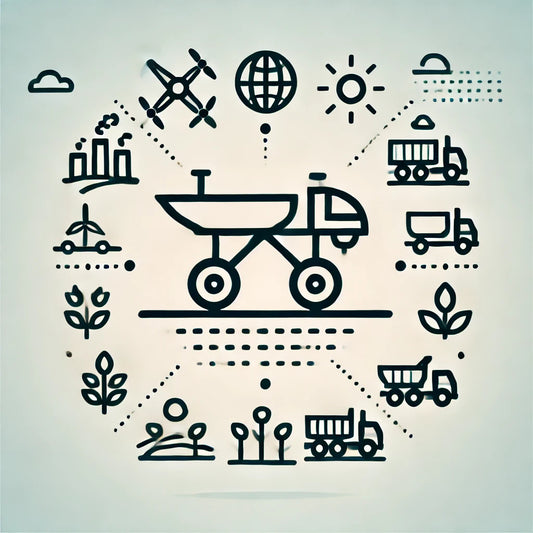-
DESCRIPTION
-
TABLE OF CONTENTS
-
SAMPLE PAGE
-
SAMPLE DOSSIER
In an ever-evolving world, logistics operations play a crucial role in how goods are delivered, assets are managed, and shipments are monitored. "The Future of Logistics Service Delivery, Fleet Management, Asset Tracking, and Shipment Monitoring Solutions" takes you on a captivating journey through technological innovations and emerging trends that are revolutionizing the logistics industry.
This book delves deep into the major advancements reshaping the way businesses plan, execute, and monitor their logistics operations. From the Internet of Things (IoT) to Artificial Intelligence (AI), blockchain, and autonomous vehicles, each chapter details groundbreaking technologies and best practices that will shape the future of logistics.
In this book, you will discover:
How IoT sensors are revolutionizing asset tracking, providing real-time visibility and precise management.
The impact of AI and automation on fleet management, route planning, and cost reduction.
Innovative applications of blockchain for creating a transparent, secure, and traceable supply chain.
Integrating robotics and drones in logistics service delivery enhances efficiency and speed.
Sustainable and green logistics practices addressing growing environmental concerns.
Delivering personalized customer experiences through advanced shipment monitoring solutions.
Whether you're a logistics professional, a researcher, or simply curious about the latest technological advances, this book provides a comprehensive overview of the future of logistics and how these developments will reshape our world.
"The Future of Logistics Service Delivery, Fleet Management, Asset Tracking, and Shipment Monitoring Solutions" is an essential guide for understanding the innovations that will shape the future of logistics and the supply chain. Get ready to dive into the exciting world of logistics to come.
Chapter I. Introduction 5
A. Background and Significance of Logistics Service Delivery, Fleet Management, Asset Tracking, and Shipment Monitoring Solutions 6
B. Purpose of the Report and Scope of Discussion 7
Chapter II. Current State of Logistics Service Delivery 9
A. Overview of Traditional Logistics Operations and Challenges 10
B. Existing Technologies and Solutions Employed in Logistics Service Delivery 12
C. Limitations and Gaps in the Current System 13
Chapter III. Emerging Trends in Logistics Technology 15
A. Internet of Things (IoT) and Its Impact on Logistics Operations 17
B. Role of Big Data and Analytics in Optimizing Logistics Processes 19
C. Artificial Intelligence (AI) and Automation in Logistics Service Delivery 21
D. Blockchain Technology and Its Potential Applications in Supply Chain Management 22
Chapter IV. Enhancing Asset Tracking Capabilities 24
A. Importance of Asset Tracking in Logistics Operations 26
B. Role of IoT Sensors in Real-time Asset Tracking and Monitoring 28
C. Leveraging Big Data and Analytics for Asset Management and Optimization 30
Chapter V. Fleet Management in the Digital Era 32
A. Challenges and Complexities of Fleet Management in Logistics 34
B. Utilizing IoT and AI Technologies for Fleet Optimization and Route Planning 36
C. Autonomous Vehicles and Their Impact on Fleet Management 38
Chapter VI. Shipment Monitoring and Visibility Solutions 40
A. Significance of Shipment Monitoring for Supply Chain Efficiency 42
B. Real-time Tracking Technologies for Enhanced Visibility 44
C. Predictive Analytics and Machine Learning for Proactive Issue Resolution 46
Chapte VII. Future Technologies and Innovations 48
A. Robotics and Drones in Logistics Service Delivery 50
B. Integration of Augmented Reality (AR) and Virtual Reality (VR) in Warehouse Operations 52
C. The Potential of 5G and Edge Computing in Logistics Technology 54
Chapter VIII. Sustainability and Green Logistics 56
A. Growing Importance of Sustainable Logistics Practices 58
B. Adoption of Alternative Energy Sources and Eco-Friendly Vehicles 60
C. Waste Reduction and Recycling Initiatives in Logistics Operations 62
Chapter IX. Customer-Centric Logistics Solutions 64
A. Evolving Customer Expectations in Logistics Service Delivery 66
B. Personalization and Customization of Logistics Experiences 68
C. Seamless Integration with E-commerce Platforms and Last-Mile Delivery Solutions 71
Chapter X. Conclusion and Future Outlook 73
A. Summary of Key Findings and Insights 75
B. Anticipated Future Developments in Logistics Technology 77
C. Implications for Logistics Service Providers and Recommendations for Future Implementation 79
Notes and Resources





